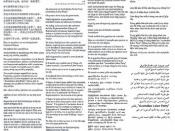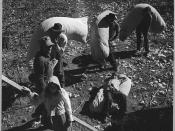Wilson Acevedo ECOB2000 Kevin Foster Term Paper
Labor Market Institutions and the Effect on the Labor Force
Labor is defined as a "measure of the work done by human beings."� In economics, the labor market seeks to explain or at least to understand some type of functioning relationship between employer (Labor Demand) and employees (Labor Supply). Therefore, the ultimately purpose for labor economics is to look at the suppliers of labor services (workers), the demanders of labor services (employers), and attempts to understand the resulting pattern of wages, employment, and income. The labor market can also be use as one aspect of the overall performance in the economy, which is how well the economy uses its resources. Since an economy's workers are its chief resource, keeping workers employed is one of the main concerns of economic policymakers. There are three important statistics that serve as indicators of economic performance. Labor force is the sum of the employed and unemployed.
The employment rate is the percentage of the population with jobs. Finally, the unemployment rate is the percentage of the population who wants to work, but do not have job.
For this economic analysis, our attention will be regarding the labor force and how it's is affected by labor market institutions. How will labor market institutions affect the labor force? How will the labor force react to active labor market policies (ALMPs)? How will the Eijfinger-Schaling index also affect the labor force? In this economic analysis, questions like these would not only be faced, but also answered. The structure of the project will be transitory from a complete analysis based on simple regressions to a more complex explanatory model using multiple variables such as Interest rate, productivity, employment rate, and unemployment rate.�
The data used was the BGHS (Baker, Glyn, Howell,



Great Read
Essay was well organized and put together. The data was very descriptive and all the additional statistics really supported your claim. Great Job.
0 out of 0 people found this comment useful.